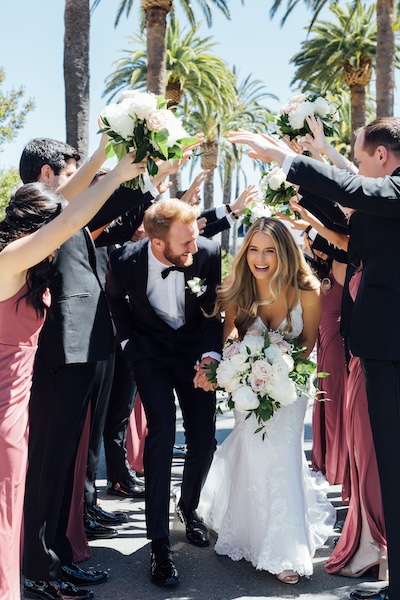Business + Marketing
It’s a mark of craftsmanship for a photographer to add his or her own stylistic signature to the retouching of images. And like the days of darkroom printing, when photographers might outsource their printing to a master, many photographers are now outsourcing their digital retouching to editing services. Opting to spend less time in front of a computer and more time on client and vendor relations, many wedding photographers are finding it to be a time-saver and a profit-generator.
Two & Quarter
In 2015, Mark and Ally Tatem of Two & Quarter Photography in Bermuda left their day jobs as media photographers to take their wedding and portrait business full time. “After tripling profits that year, we made the decision to outsource our editing because our free time was spent editing, and our turnaround times were almost always nearing our maximum,” they explain.
Last year at WPPI, they met with representatives from several editing companies and decided to hire Prime Edits. “We wanted the ability to form a relationship with a single editor, we wanted to find a company that was able to tailor editing to suit our specific needs and style, and lastly, we wanted a company that had clear pricing structures,” they say of their retouching requirements.
Today, they outsource the majority of their shoots to the company, while remaining transparent with their clients about the process. “Because our clients are aware that our editing process is done ‘out-of-house,’ they’re less inclined to ask for favors and quick fixes as there is a better understanding that further manipulation, other than what is included, will come at an additional cost.”
In the last year they’ve seen their profits increase by roughly 70 percent because they’ve been able to bill more hours behind the camera instead of the computer.
“Outsourcing such a large portion of our workflow has allowed us the time to focus on growing our business, launching additional service options and having better relationships with each client. Our turnaround times are a fraction of what they were, even with more jobs to process.”
FROM THE RETOUCHER: Prime Edits, Dustin Brown
• New this year •
“So many photographers are adding video to their arsenal but are still unsure about how to produce the final products. We produce highlight videos and long-form videos from the photographer’s audio and video clips.”
• Trend I’m seeing •
“Everybody loves VSCO and Mastin Labs. Creating the film look is one of our most requested styles.”
• Editing tip •
“Don’t sweat the small stuff. Focus on creating photos that tell the story instead of obsessing about removing each stray blade of grass from every image. Put any extra time on polishing up two or three images from a wedding that can be the ones you suggest as wall art.”
Paul Rich Studio
“There are three things I outsource in my life: Bookkeeping, housecleaning and image cleaning,” says Paul Rich. “These are things that are not my forte and that other people can do quite well.”
Having worked with RetouchUp (a division of Hollywood Fotofix) for the past five years, the Portland, Oregon-based photographer began sending them work that required increasing levels of retouching expertise, and he says they consistently exceed his expectations. The greatest benefit to him is their turnaround time, which has sped up the delivery of work to his clients as well as the quality of the work he provides. “My goal as a photographer is to spend as much time out in the field as possible and as little time in front of a computer as possible,” he says.

Top: The original photograph. Bottom: The same photograph after being edited by RetouchUp. No matter the difficulty, Paul Rich finds that RetouchUp takes care of his images. Photos © Paul Rich
In addition, Rich’s workflow is more seamless now and his business more profitable. “Special retouching requests are billed according to the level of complexity, and the costs I incur are passed along to the client and appropriately marked up.”
Rich suggests photographers make sure they find a studio that’s receptive to their specific editing needs. “The most critical aspect of working with a retoucher is communication.”
FROM THE RETOUCHER: ReTOUCHUP, Gary Poole
• New this year •
“Our new photo restoration service allows clients to send work for repair and restoration for one price, regardless of the extent of damage.”
• Working with your style •
“Clients can communicate their style by simply typing in their instructions or sending samples or even personalized training videos. We use whichever tool is appropriate based on need.”
• Mistake to avoid •
“Not getting the best image right out of the camera. Photographers, take great care to reduce eyeglass glare, remove sensor dust and lint, and get the lighting right. And if you’re always having to fix the same scratch on a backdrop, paint or fix the backdrop.”
Roberto Valenzuela
“I think at the beginning of your career, it’s not a bad idea to edit your own photos,” says L.A.-based photographer Roberto Valenzuela. “But once you want to start running a functional and profitable business, editing your own photos is a real waste of time.”
For Valenzuela, this was a hard lesson to learn. “My business started doing well but I also started burning out. I could spend 40 hours just editing one wedding. It’s better to get into the mindset that your job is to be a photographer and a businessperson, not to do all the backend stuff.”
As long as the images are properly exposed, balanced for color, cropped and straightened, he says clients don’t care how long you spend editing or where the images are edited. For the past five years, he’s been using ShootDotEdit to retouch his volume shoots. “Anytime you have a shoot with more than 100 images, it’s always good to hire an editing service,” Valenzuela says.
He particularly likes ShootDotEdit’s new stylistic match service, which works within the parameters he specifies. “I don’t like high contrast and highly saturated images,” he says. “I want colors to be toned down by about 15 percent. I like my images to be slightly overexposed by about 1/3 of a stop. I also want everything straight,” and ShootDotEdit returns 800 to 1,000 images to him in 48 hours.

Roberto Valenzuela likes how ShootDotEdit follows his specific editing look to a T, letting him focus on other aspects of his business. Photo © Roberto Valenzuela
Most importantly, outsourcing frees him up to do the serious work of a business owner. “If I had a backlog of weddings to edit, I would never have the time to meet with wedding coordinators, who pretty much run the show in Los Angeles,” Valenzuela says. Now his workflow ends once he’s culled images.
“Not having to do my own photo editing keeps me more alert, more energetic and more excited when I’m on a shoot. It makes me a better photographer.”
FROM THE RETOUCHER: SHOOTDOTEDIT, Jared Bauman
• New this year •
“Style Match™ is our newest addition, a process we go through to uniquely match every single photographer’s personal style and provide a finished solution.”
• Editing tip •
“Use the most up-to-date programs, like Lightroom, to create a fast and simple post-wedding workflow from start to finish.
• Mistake to avoid •
“Focus on developing your style and not constantly changing it. While it can be exciting to play around with different looks, your clients book you because of the style they saw on your website or blog. A consistent style will also help you have an efficient workflow.”
• Working with retouchers •
“Submit your job to us as soon as you can after shooting it. A smooth and stress-free workflow starts with quickly moving jobs in and out of your studio, especially during busy season. The faster you turn your images around to your client, the happier they will be, and the more money you will make!”
JAGstudios
For Jacklyn Greenberg of JAGstudios in Connecticut, outsourcing her and her partner Chris Brown’s retouching needs was a careful calculation. They made intricate spreadsheets to weigh the cost and time of managing in-house editors versus outsourcing through a company. “When we clocked every hour applied to a wedding or portrait shoot throughout the editing process—from initial download and culling all the way to color correcting and creating galleries—we found we were spending anywhere between 24 to 30 hours per wedding.” Outsourcing reduced editing time to about 10 to 12 hours per wedding, she notes; culling and editing with the same outside service brought them down to about two to four hours per wedding.
“It was pretty straightforward that for the investment, the time that was freed up allowed us to grow our business substantially, instead of spending hours doing something we already excelled at,” she says. “So we didn’t decide to outsource because we couldn’t do the work ourselves, but because it was a smart way to grow our business.”
Greenberg says they trust their post-production to photographers Davina and Daniel’s The Image Salon. “We still turn our jobs around in the same amount of time,” she says, “because we want the client to understand the time we’re taking to refine the photos to their finished state. And then we have room to exceed expectations if we turn the work around more quickly than promised.”

Top: The original photograph. Bottom: The same photograph after retouching by The Image Salon. Sorting out the pros and cons, Jacklyn Greenberg found that outsourcing would cut time in the editing room by over 20 hours per wedding. Photos © JAGstudios
The results are huge. Greenberg says they no longer have to advertise because client referrals have picked up. Instead of retouching, their time goes toward building relationships with vendors and clients.
From the Retoucher: THE IMAGE SALON, DANIEL KUDISH
• New this year •
“We recently launched a Portrait Editing service to help photographers who shoot babies, families, boudoir and other portrait work.”
• Trend I’m seeing •
“There’s more emphasis on print and album sales. As a result, the post-production is done in two phases: one for proofs and one for final prints.”
• Working with your style •
“We have kick-off calls with our clients where they sit down with one of our managers, who will live-edit with them, and then prepare all of the notes and preferences for their editor when that first order comes in. Clients can also have a review call with their editor to go over what kind of tweaks they might still need.”
• Working with retouchers •
“Your feedback in the initial stage is crucial, and we know not to take anything personally. You can (and should) always be honest.”
Click here to read the article in the digital edition.








